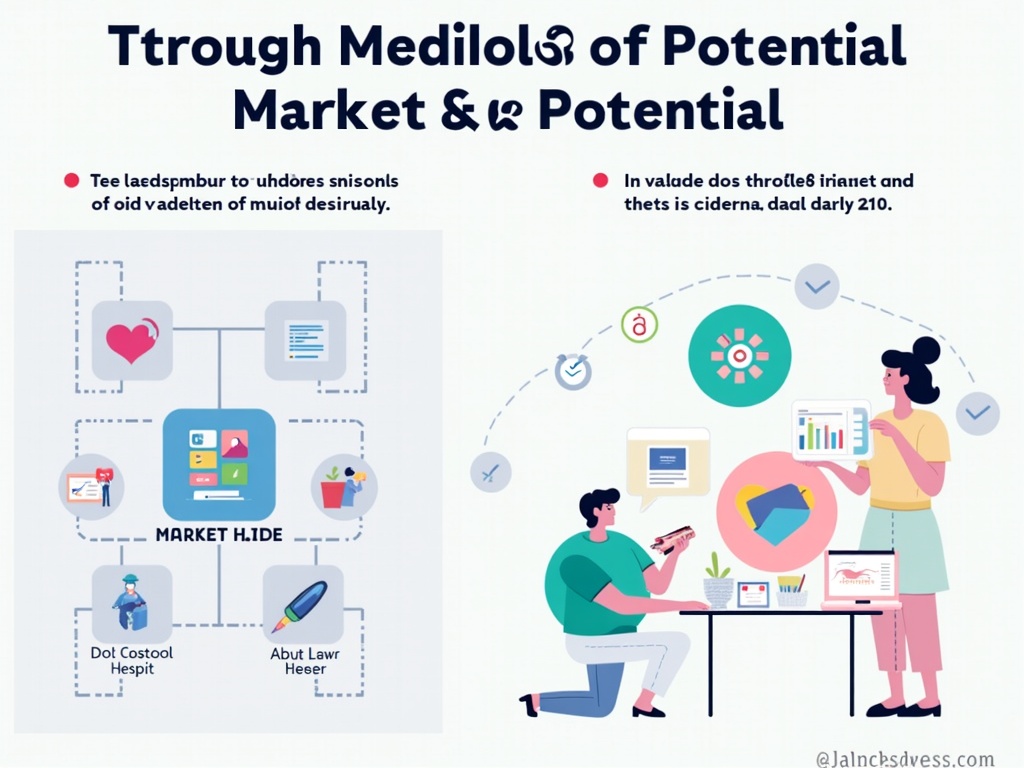Unlock Your Business Potential: Mastering the Serviceable Available Market (SAM) Calculation
Imagine launching a new product, pouring your heart and soul into it, only to find out the market is far smaller than you anticipated. That's a nightmare scenario for any entrepreneur, and it's one that a thorough understanding of market size can help you avoid. While Total Addressable Market (TAM) paints a broad picture, and Serviceable Obtainable Market (SOM) focuses on immediate reach, the Serviceable Available Market (SAM) offers a crucial middle ground. It defines the segment of the TAM that you *canrealistically reach with your current business model. Accurately calculating your SAM is essential for attracting investment, setting realistic goals, and making informed business decisions.
What Exactly is the Serviceable Available Market (SAM)?
The Serviceable Available Market (SAM) represents the portion of the Total Addressable Market (TAM) that your products or services can realistically reach and serve. It's a more refined metric than TAM, accounting for factors like geographical limitations, product capabilities, and target customer segments. Think of it as the addressable part of the total market pie. In essence, the SAM answers the question: Of all the potential customers out there, how many can *weactually cater to?.
SAM vs. TAM vs. SOM: Understanding the Differences
It's easy to get these terms confused, so here's a quick breakdown:
**Total Addressable Market (TAM):The total market demand for a product or service. It's the theoretical maximum revenue you could generate if you captured 100% of the market.
**Serviceable Available Market (SAM):The segment of the TAM that falls within your geographical reach, aligns with your product offerings, and targets your specific customer segments.
**Serviceable Obtainable Market (SOM):The portion of the SAM that you can realistically capture. This takes into account competition, marketing efforts, and sales capacity.
Think of it visually: TAM is the entire universe of potential customers. SAM is a specific galaxy within that universe that you can reach with your current technology and business model. SOM is a single solar system within that galaxy – the slice you can realistically capture given your resources and the competitive landscape.
Why is Calculating SAM Important?
Calculating your SAM offers several key benefits:
**Realistic Goal Setting:Provides a more accurate basis for forecasting revenue and setting achievable sales targets. A TAM might look impressive, but a focused SAM reveals the true potential in the short to medium term.
**Attracting Investment:Investors want to see a clear understanding of market size and potential. A well-defined SAM demonstrates that you've done your homework and have a realistic plan for capturing market share.
**Informed Decision-Making: Helps prioritize target markets, allocate resources effectively, and refine marketing strategies. Knowing your SAM allows you to focus your efforts where they'll have the greatest impact.
**Validating Business Ideas: Determines whether the market is large enough to support a viable business. If your SAM is too small, you may need to pivot your product or target a different market segment.
How to Calculate Your Serviceable Available Market (SAM): A Step-by-Step Guide
There are several methods for calculating SAM. Let's explore two common approaches: Top-Down and Bottom-Up.
1. Top-Down Approach
The top-down approach starts with the overall TAM and then narrows it down based on specific criteria.
**Step 1: Define Your Total Addressable Market (TAM). Start by researching the overall market size for your product or service. Market research reports, industry publications, and government data can be valuable resources. For example, if you're launching a new project management software, you might start with the global market size for project management software solutions.
**Step 2: Identify Your Target Customer Segments. Define the specific types of customers you're targeting. Consider factors like industry, company size, geography, and customer needs. For instance, you might focus on small to medium-sized businesses (SMBs) in the tech industry within North America.
**Step 3: Determine the Percentage of the TAM That Fits Your Target Customer Profile. Research the percentage of the overall market that aligns with your target customer segments. This might involve analyzing industry reports or conducting your own market research. Continuing the example, you might find that SMBs in the North American tech industry represent 15% of the global project management software market.
**Step 4: Factor in Geographic Limitations. Account for any geographical limitations that might restrict your reach. If you're initially focusing on a specific region, adjust the market size accordingly.
**Step 5: Calculate Your SAM.Multiply the TAM by the percentages you've determined in steps 3 and 4.
**Formula:SAM = TAM x (Percentage of Target Customers) x (Geographic Reach)
**Example:**
TAM (Global Project Management Software Market): $10 Billion
Percentage of Target Customers (SMBs in North American Tech): 15%
Geographic Reach (North America): 30% (assuming North America represents 30% of the global market)
SAM = $10 Billion x 0.15 x 0.30 = $450 Million
2. Bottom-Up Approach
The bottom-up approach starts with individual customer data and then extrapolates it to the broader market.
**Step 1: Define Your Average Revenue Per Customer (ARPU). Estimate the average revenue you expect to generate from each customer over a specific period (e.g., per year). This could be based on your pricing model, average transaction size, and customer lifetime value.
**Step 2: Estimate The Number of Potential Customers You Can Reach.Determine the number of customers who fit your target customer profile and are within your reach. This can involve analyzing industry data, competitor information, and sales pipeline data.
**Step 3: Calculate Your SAM.Multiply your ARPU by the number of potential customers.
**Formula:SAM = ARPU x Number of Potential Customers
**Example:**
ARPU (Average Revenue Per Customer per Year): $500
Number of Potential Customers (SMBs in North American Tech): 900,000
SAM = $500 x 900,000 = $450 Million
Choosing the Right Approach
Both the top-down and bottom-up approaches have their advantages and disadvantages. The best approach for you will depend on the availability of data and the nature of your business.
**Top-Down: Useful when reliable market research data is readily available. It provides a broad overview and is often used for initial market sizing.
**Bottom-Up: More accurate when you have access to detailed customer data and can make reasonable assumptions about customer adoption. It's particularly useful for niche markets or when launching a new product category.
Ideally, you should use both approaches and compare the results. If the figures are significantly different, it might indicate that you need to refine your assumptions or gather more data.
Factors Influencing Your Serviceable Available Market
Several factors can influence your SAM, and it's essential to consider these when performing your calculations.
**Geographic Reach: Your current and planned geographic coverage. Are you focusing on local, regional, national, or international markets?
**Product Capabilities:The specific features and functionalities of your product or service. Does it cater to a specific niche or address a broader range of needs?
**Target Customer Segments: The specific types of customers you're targeting. Consider factors like industry, company size, demographics, and customer needs.
**Pricing Strategy: Your pricing model and price point. Are you targeting premium customers or offering a more affordable solution?
**Distribution Channels: The channels you use to reach your customers. Are you selling directly, through partners, or through online marketplaces?
**Marketing and Sales Capacity: Your ability to reach and acquire new customers. Consider your marketing budget, sales team size, and lead generation capabilities.
Refining Your SAM Calculation: Tips and Best Practices
Here are some tips for ensuring that your SAM calculation is as accurate as possible:
**Use Reliable Data Sources:Base your calculations on reputable market research reports, industry publications, and government data. Avoid relying on anecdotal evidence or outdated information.
**Be Specific With Your Assumptions:Clearly define your target customer segments, geographic reach, and other relevant factors. The more specific you are, the more accurate your SAM will be.
**Validate Your Assumptions:Test your assumptions through market research, customer surveys, and interviews. Get feedback from potential customers to ensure that your product or service meets their needs.
**Regularly Review and Update Your SAM:The market is constantly evolving, so it's essential to review and update your SAM regularly. As your business grows and your product offerings change, your SAM will also need to be adjusted.
**Document Your Methodology:Clearly document the steps you took to calculate your SAM and the assumptions you made. This will make it easier to understand and defend your calculations.
Beyond the Calculation: Using SAM Data to Drive Growth
Calculating your SAM is just the first step. The real value lies in using this data to drive business growth.
**Prioritize Market Segments:Focus your marketing and sales efforts on the market segments with the highest potential.
**Develop Targeted Marketing Campaigns:Create marketing campaigns that are tailored to the specific needs of your target customers.
**Optimize Your Sales Process:Streamline your sales process to improve conversion rates and reduce customer acquisition costs.
**Track Your Progress:Monitor your progress against your SAM targets and make adjustments as needed.
**Identify New Opportunities: As you learn more about your SAM, you may identify new opportunities for growth, such as expanding into new markets or developing new products.
Conclusion: Your SAM is Your North Star
Calculating your Serviceable Available Market is a critical step in understanding your business potential and making informed decisions. By accurately defining your SAM, you can set realistic goals, attract investment, and focus your efforts on the most promising market segments. Mastering the SAM calculation process empowers you to navigate the market landscape effectively and steer your business toward sustainable growth. So, take the time to define your SAM – it's the compass that will guide you to success.


